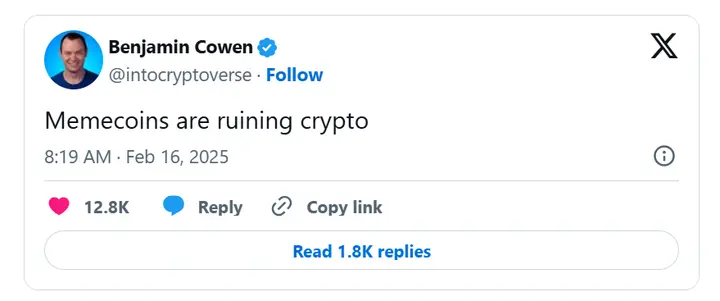Original title: "Memecoins- The inevitable path to mainstream adoption or the symptom of a broken system?"
By Jen Albert
Compiled by: Vernacular Blockchain
As a moderator on Blockchain Banter, I recently led a discussion on memecoins - a topic that has sparked intense debate across the industry. Whether you love them or hate them, there’s no denying their influence. Some believe they are ruining the crypto industry, while others see them as a natural progression in the development of a decentralized market.
To further analyze this debate, I invited Justin Havens (Head of Ecosystem Growth at Polygon DeFi) and Dr. Mark Richardson (Project Leader at Bancor & Carbon DeFi) to discuss it. We had an in-depth discussion around the following core topics:
- The origins of Memecoins and their role
- Regulatory challenges
- Investor vs. Gambler Mentality
- Influencers vs. Key Opinion Leaders (KOLs)
- The possibilities and limitations of DYOR (Do Your Own Research)
This conversation reveals the multiple impacts of memecoins in the crypto market, and you are welcome to join us in the discussion!
1. The Memecoin Controversy
Memecoins have sparked a huge divide in the crypto space. Some see them as a fun and community-driven way to participate in the market, while others believe they undermine the industry's legitimacy. On one hand, well-known figures like Benjamin Cowen even bluntly said: "Memecoins are ruining the crypto industry."

On the other hand, we’ve also seen some industry heavyweights take the opposite view, such as BN (Binance) co-founder and former CEO Changpeng Zhao (CZ), who seemed to be encouraging (or not 😏) the creation of more memecoins by posting a photo of his pet dog Broccoli with a full-page background story.
“I just posted a picture and name of my dog. I did not issue a memecoin myself, and it is entirely up to the community to create one (or not). However, I may interact with some of the more popular memecoins on BNB Chain (BSC). The BNB Foundation may provide rewards for the top memecoins on BNB Chain, such as LP support or other incentives. The details are still being discussed, so stay tuned.”

Justin believes that memecoins are not accidental products, but the inevitable result of regulatory crackdowns on the issuance of structured tokens. Due to concerns about legal risks, project owners have to choose the following methods:
- Completely avoid any discussion related to the utility of tokens
- Choose to raise financing and exclude retail investors
- Issuing Tokens without a clear purpose
So what happens when the only viable way to issue public tokens is to issue tokens with no real use? The answer is the rise of memecoins.
Mark further pointed out that “market incentives determine the final result.” Regulators have created an environment where tokens with practical uses fall into a legal gray area, while tokens that clearly claim to be “useless” face almost no compliance risks. The result is that memecoins quickly dominate.
2. Investors or gamblers? The subtle line in the crypto market
One of the biggest misconceptions in the crypto space is that there’s a clear line between investing and gambling. But does that line really exist?
Investors study fundamentals, assess risks, and make decisions with a long-term perspective.
Gamblers chase hot spots, trade impulsively, and accept extreme risks.
Justin pointed out that many retail traders are forced into a "gambling mentality" because they cannot participate in traditional early-stage investments. Unless you are an accredited investor, your only option is speculative trading - which includes memecoins.
Mark believes that the line is more blurred than most people think. After all, many of the best performing crypto assets in history have been obvious scams. As he puts it:
“People will tell you not to invest in this, saying it’s a scam. Others will say, ‘I know it is.’ ”
It’s this paradox that fuels the craze for memecoins — the projects that look the most like scams sometimes bring the biggest gains.
3. Did KOLs fuel the Memecoin craze?
The topic naturally turns to KOLs (key opinion leaders) and paid influencers, which are important drivers of the memecoin ecosystem. So, are the root of the problem memecoins themselves, or those who promote them for profit?
- In fact, there is a fundamental difference between real KOLs and paid influencers:
- Real KOLs are respected industry builders and experts.
- Paid influencers often promote the tokens they are paid to advertise, creating the illusion of "natural market attention."
This also explains the other side of memecoin hype - is it market demand that creates them, or is it artificially fueled?
4. Is the term KOL being abused in the crypto circle?
Mark believes that the term "KOL" is often misused in the crypto space. Many so-called "opinion leaders" are essentially just advertisers who resell token shares behind the scenes. If a project needs to pay people to talk about it, it's worth thinking: why does it need to do this?
What is the core? Question the incentive mechanism. If someone is desperately promoting a token, ask yourself first - what can they gain from it?
5. DYOR: Is it really feasible?
The phrase "Do Your Own Research (DYOR)" is often emphasized in the crypto community, but the reality is often much more complicated than the slogan. As audience member Mike pointed out, DYOR is easier said than done.
Most people lack both the tools and the expertise to properly analyze:
- Token Distribution
- Potential risks of smart contracts
- Liquidity structure and other key factors
While true on-chain analysis requires a certain amount of investment, there are indeed some tools that can help, such as Bubble Maps, which can visually track token distribution and identify potential scams. But at the end of the day, if you don’t fully understand what you are buying, then you are more like gambling than investing.
6. Can Memecoins also evolve? Take Sei as an example
There is a counter-argument to the discussion: some memecoins started out as jokes but later developed into real projects.
Seiyan (a memecoin on the Sei chain) is a typical case - it started out as just a memecoin, but later launched its own aggregator to turn the community's momentum into a more practical product.
The line between memecoins and utility tokens is not always clear. Sometimes, memecoins can grow into real projects and contribute far more to the ecosystem than just a “fun token”.
7. Conclusion: Memecoins will not disappear
Memecoins remain one of the most controversial topics in the crypto industry, and the discussion is far from over.
But one thing is clear - memecoins have become part of the market and are not going away in the short term. Their demand is market-driven, and until regulation is clear and unable to support structured token issuance, memecoins may continue to dominate.
So, what is the root cause of the problem?
Is it memecoins themselves?
Is it the speculative mentality of KOLs and the market?
Or is it the imperfection of the regulatory system?
As Justin concluded:
“If you fix the incentives, you can fix the market.”















